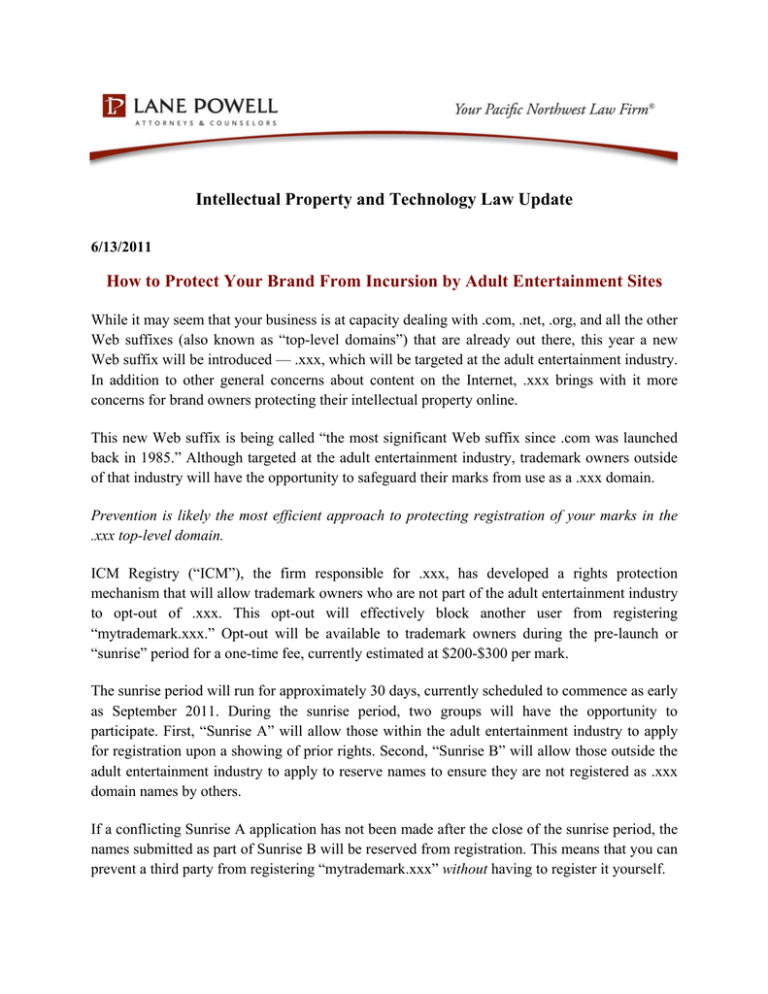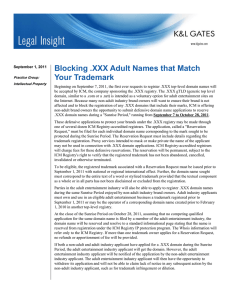Intellectual Property and Technology Law Update
advertisement

Intellectual Property and Technology Law Update 6/13/2011 How to Protect Your Brand From Incursion by Adult Entertainment Sites While it may seem that your business is at capacity dealing with .com, .net, .org, and all the other Web suffixes (also known as “top-level domains”) that are already out there, this year a new Web suffix will be introduced — .xxx, which will be targeted at the adult entertainment industry. In addition to other general concerns about content on the Internet, .xxx brings with it more concerns for brand owners protecting their intellectual property online. This new Web suffix is being called “the most significant Web suffix since .com was launched back in 1985.” Although targeted at the adult entertainment industry, trademark owners outside of that industry will have the opportunity to safeguard their marks from use as a .xxx domain. Prevention is likely the most efficient approach to protecting registration of your marks in the .xxx top-level domain. ICM Registry (“ICM”), the firm responsible for .xxx, has developed a rights protection mechanism that will allow trademark owners who are not part of the adult entertainment industry to opt-out of .xxx. This opt-out will effectively block another user from registering “mytrademark.xxx.” Opt-out will be available to trademark owners during the pre-launch or “sunrise” period for a one-time fee, currently estimated at $200-$300 per mark. The sunrise period will run for approximately 30 days, currently scheduled to commence as early as September 2011. During the sunrise period, two groups will have the opportunity to participate. First, “Sunrise A” will allow those within the adult entertainment industry to apply for registration upon a showing of prior rights. Second, “Sunrise B” will allow those outside the adult entertainment industry to apply to reserve names to ensure they are not registered as .xxx domain names by others. If a conflicting Sunrise A application has not been made after the close of the sunrise period, the names submitted as part of Sunrise B will be reserved from registration. This means that you can prevent a third party from registering “mytrademark.xxx” without having to register it yourself. To qualify for Sunrise B, a party must show a valid national trademark or service mark registration that was issued prior to the time of the Sunrise B application in a country where the applicant conducts substantial business in connection with the registered mark. The opt-out application must correspond exactly to the entire text of a text mark, or the textual component of a graphical mark. Sunrise A applicants must also satisfy the trademark-ownership criteria listed above or must own and operate an existing domain name that corresponds to the .xxx domain name applied for. If competing applications are received by ICM from both a Sunrise A applicant (e.g., a party in the adult entertainment industry) and a Sunrise B applicant (e.g., a trademark owner seeking optout), ICM will notify both parties and give the Sunrise A applicant an opportunity to withdraw its application. However, registration of the domain name to the Sunrise A applicant will proceed if the Sunrise A applicant does not withdraw its application. In such a scenario, the trademark owner would have to consider other dispute-resolution options. In future disputes, the Sunrise A applicant would not be able to claim it lacked notice of the trademark owner’s rights. After the sunrise period, a short “landrush” period will commence. During the landrush, those in the adult entertainment industry will be allowed to apply for .xxx domain names, with no requirement to show trademark rights or other prior rights. Once the sunrise and landrush periods have closed, registration will be run on a first-come, firstserved basis with no pre-emptive rights protection in place. While a service may be available in the future to deal with new trademarks, ICM currently states that no future opt-outs will be offered. Trademark owners will, however, continue to have enforcement options available to them, which are currently used to resolve domain name disputes, such as the Uniform Domain Name Dispute Resolution Policy (commonly referred to as UDRP) and litigation. For more information, please contact the Intellectual Property and Technology Practice Group at Lane Powell: IPGroup@lanepowell.com This is intended to be a source of general information, not an opinion or legal advice on any specific situation, and does not create an attorney-client relationship with our readers. If you would like more information regarding whether we may assist you in any particular matter, please contact one of our lawyers, using care not to provide us any confidential information until we have notified you in writing that there are no conflicts of interest and that we have agreed to represent you on the specific matter that is the subject of your inquiry. Copyright © 2011 Lane Powell PC 2






